7 /10 1 Votes7
Director(s) Kanji Wakabayashi Genre Visual novel Developers 5pb., Nitroplus | 7/10 MyAnimeList Producer(s) Tatsuya Matsubara Initial release date 18 December 2014 Publishers 5pb., Nitroplus | |||||||||||||||||||||||||||||||||
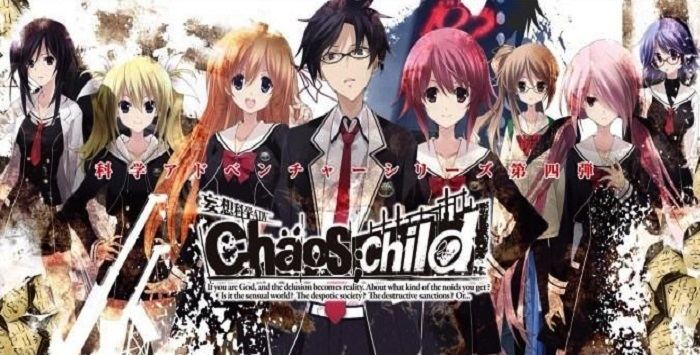 | ||||||||||||||||||||||||||||||||||
Artist(s) Mutsumi SasakiYukihiro MatsuoChoco Writer(s) Naotaka HayashiEiji UmeharaMasashi TakimotoTōru Yasumoto Release date(s) Xbox OneJP: December 18, 2014PS3, PS4, PS VitaJP: June 25, 2015Microsoft WindowsJP: April 28, 2016iOSJP: January 31, 2017 Similar Science Adventure games, 5pb games, Other games | ||||||||||||||||||||||||||||||||||
Chaos;Child (Japanese: カオスチャイルド, Hepburn: Kaosu Chairudo, stylized as ChäoS;Child) is a visual novel video game developed by 5pb. It is the fourth main entry in the Science Adventure series, and a sequel to Chaos;Head (2008). It was released in Japan in 2014 for Xbox One, in 2015 for PlayStation 3, PlayStation 4 and PlayStation Vita, in 2016 for Microsoft Windows, and in 2017 for iOS.
Contents
- Gameplay
- Setting and characters
- Main Route
- Nono Route
- Hana Route
- Hinae Route
- Uki Route
- Chaos Child Route True Ending
- Development
- Release
- Reception
- References
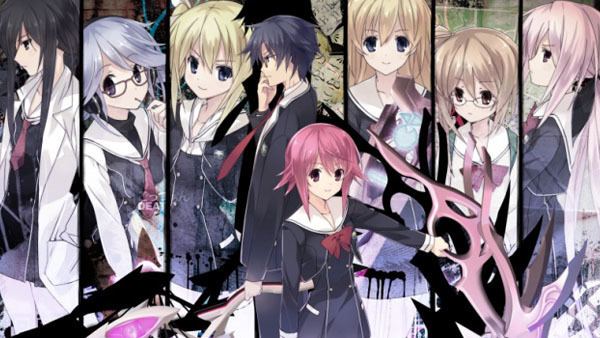
The player takes the role of Takuru Miyashiro, the president of his school's newspaper club, who experiences delusions. At multiple points throughout the story, the player gets the option to choose if Takuru should experience a positive or negative delusion, or neither: these choices affect the plot's direction, causing it to branch off from the main narrative into different routes.

The game was created to have "psycho-suspense" elements similar to Chaos;Head, while also adding a larger amount of horror elements. For the game's aesthetic, the developers aimed for it to be "unmoving", in contrast to the previous Science Adventure game, Robotics;Notes. The composer, Takeshi Abo, wrote down his impressions of the game's events and emotional flow prior to creating the music, to be able to create music with good relationship to the game's worldview. The game was well received by critics, but the Xbox One and PlayStation 3 releases failed to chart on Japanese weekly sales charts during their debut weeks. Other media based on the game has been produced, including an anime adaptation, a manga, an audio drama, and the spin-off game Chaos;Child Love Chu Chu!!.
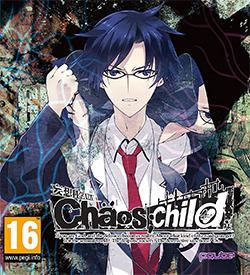
Gameplay
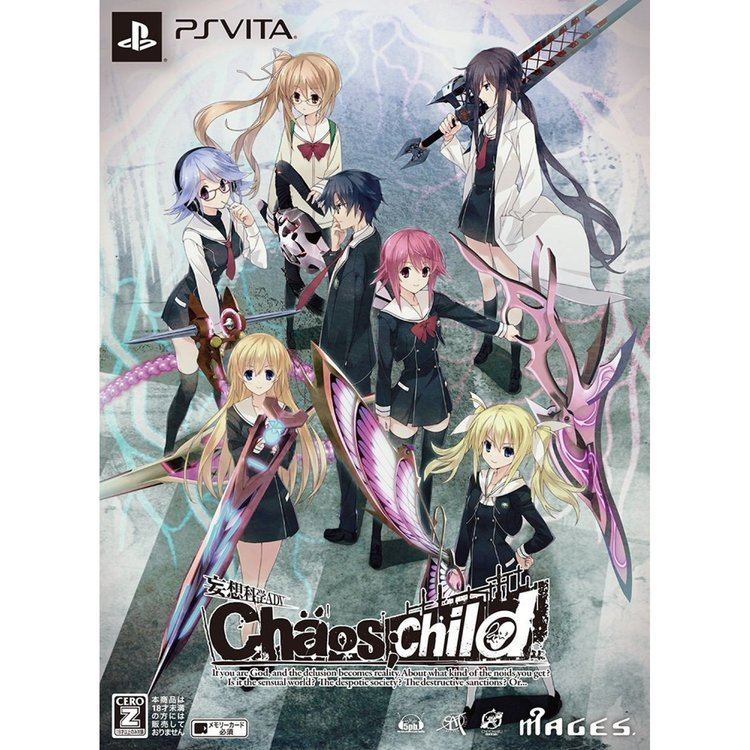
Chaos;Child is a visual novel, which is split into multiple different story routes. During a first playthrough of the game, the player can only play the main narrative; after finishing the game once, other routes that branch off of the main narrative at different points become available. Each route focuses on one of the game's characters, dealing with character motivations and secrets not revealed in the main narrative.
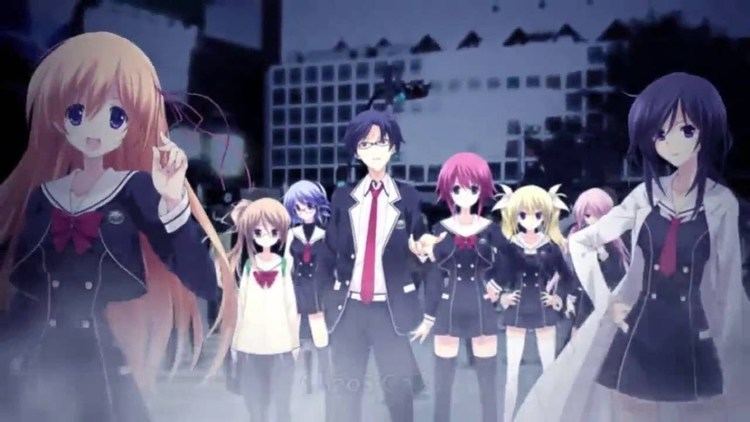
At multiple points, the player gets the option to choose whether the player character should experience a positive delusion or a negative one; they can also choose neither and stay rooted in reality. These choices change the player character's world view, as well as who he trusts, and are what causes the story to branch into different endings.
Setting and characters
Chaos;Child is set in Shibuya in 2015, six years after the events of Chaos;Head, where an earthquake nearly leveled the area. It follows a group of high school students who survived the earthquake; among them is the player character Takuru Miyashiro, who is a senior in high school and president of the school's newspaper club, and whose family died in the earthquake. He is accompanied by his childhood friend Serika Onoe and his foster sister Nono Kurusu, who are the game's main heroines and romantic leads. Among other characters are the newspaper club members Hana and Itou; Hinae, an eyewitness to a murder; Uki, who has spent years isolated from the world; and Mio, a misanthrope who has been sent in to aid the police. Several of the characters have superhuman abilities: for instance, one can spot lies with absolute certainty, while another can use pyrokinesis.
Main Route
Six years after the events of Chaos;Head, the city of Shibuya has been rebuilt and the survivors have continued with their lives. However, a new series of odd killings begin to occur on the same days of the New Generation murders, and are done in similarly odd ways, leading people to begin calling them the New New Generation murders. Takuru takes a personal interest in the murders and begins investigating them with the help of his fellow club members, much to Nono's dismay. Mio and Shinjou are also investigating the murders on the behalf of the police and Mio's own motives. Eventually, Takuru follows a set of clues to a love hotel where he encounters Hinae, a fellow student at his school at the scene of another killing. Hinae afterwards reluctantly agrees to assist Takuru and Mio in their investigations.
After more killings, Takuru learns that they are all connected by the presence of Sumo Stickers at the crime scenes, and he receives a tip to investigate the basement of AH Tokyo General Hospital where the creator of the Sumo Stickers is allegedly being kept. Takuru, Serika, and Itou sneak into the hospital, where both Takuru and Serika have flashbacks of a girl being experimented on. They then meet Mio, who reveals that there is a secret facility under the hospital created by the Committee to study Gigalomaniacs, individuals possessing the power to create delusions. She breaks into the facility's computer network and reveals the Committee created the Sumo Stickers and were responsible for experimenting on Senri, the girl Takuru and Serika had seen in the past. Mio then kidnaps another test subject, Uki, and the group makes their escape. Afterwards, Mio further explains to Takuru that he most likely is a Gigalomaniac himself, and Hinae manifests her Di-Sword and demonstrates her ability to detect lies to prove it to him. Takuru also surmises that all of the victims in the New New Generation murders are also Gigalomaniacs.
Later, Takuru and Hinae are attacked by a pyrokinetic Gigalomaniac whom they suspect to be the killer. Nono also reveals to them that she was childhood friends with Senri and was aware of the experiments that were being performed on her, and decides to help in their investigation as well. Working together, Takuru and his friends manage to avoid becoming victims in the subsequent New New Generation murders, until the pyrokinetic herself is found dead. Everybody lets their guard down, believing the murders to be over until Itou murders Takuru and Nono's adopted younger sister, Yui. Itou claims it is revenge for leaving Senri to die, but Nono concludes that Itou is being mind controlled. Itou the collapses from the strain of the mind control.
Some time after Yui's murder, Takuru follows Nono to the roof of the school, where he finds Nono and Serika battling each other with Di-Swords. Takuru attempts to intervene, but Nono is killed by Serika, who leaves the scene. Takuru is implicated in Nono's death and becomes the prime suspect for the New New Generation murders, so he decides to hide out with Mio. Serika then arrives and reveals that she is in fact a delusion created by Takuru during the earthquake when his powers manifested, her sole purpose being to protect him. She also reveals that Takuru and Nono's adoptive father, Sakuma, is in fact responsible for the New New Generation murders and is a Committee member seeking to exterminate the remaining Gigalomaniacs. She pleads for Takuru and his friends to flee Shibuya before leaving. Hinae warns Takuru that Serika was not being entirely truthful about her desire to protect him, so he decides to confront her again to find out for sure.
Takuru heads for the Theater Cube to confront Serika again, but instead met by Sakuma, who has his own Di-Sword and a backpack capable of generating delusions. Traps Takuru in several delusions in an attempt to destroy his sanity, but Takuru is able to hold on to his sense of self and uses his own Di-Sword to kill Sakuma. He then battles Serika and views her memories, finding out that Serika was created to carry out his innate desire to be a hero like Takumi, who solved the New Generation murders. In order to achieve this desire, Serika manipulated Sakuma into arranging the New New Generation murders for Takuru to solve. Realizing everything is his fault and not wanting to play Serika's game any longer, Takuru uses his powers to turn Serika into a normal girl.
In the aftermath, Takuru's surviving friends go about their daily lives. Takuru himself is taken into police study and Serika has gone missing. Takuru is reported to have died while in police custody, while Serika asks him if hew as able to do what he wanted to do.
Nono Route
This route triggers if Takuru was able to intervene in Nono and Serika's duel and saves Nono's life. Upset that Takuru saved Nono, Serika leaves. Takuru asks Nono what her power is and she replies her power is similar to Hinae's lie detection. Sakuma ends up becoming the next New New Generation murder victim. Takuru, Nono, and their friends attempt to continue a normal life afterwards, until Serika appears again and reveals that Nono is in fact Senri. The real Nono died in the Shibyua earthquake, and Senri so desperately wanted to be like Nono that she gained the power of transformation, taking on Nono's appearance and identity. Takuru becomes angry a Senri for lying to him and forces her away. However, he comes to regret his outburst after realizing that despite taking on Nono's appearance, Senri's love for him was still real. Takuru subsequently loses the will to live and Serika arrives to kill him and fulfill his desire. Senri intervenes and Takuru's desire changes to being with Senri. Seeing that she no longer has any purpose, Serika kills herself. Afterwards, Senri takes on her original identity and lives happily together with Takuru as they go visit the real Nono's grave.
Hana Route
This route triggers if Takuru decides to flee to the school to evade Haida. There, he runs into Hana, who uses her powers to summon a portal device from her favorite game "Ensue 2", which defeats Haida. Takuru takes shelter with Hana at her home, where she explains that she has the ability to to make the words she speaks reality. However, she doesn't have full control over ability, so she voluntarily stays mute to keep herself from accidentally harming others. They soon learn about numerous other portal devices appearing around Shibuya that are creating monsters from Ensue 2. One of Hana's gaming friends warns them about the Committee, and that one of their teachers, Wakui, is a member. Wakui captures Nono and holds her hostage to force Hana and Takuru to meet him, intending to capture Hana for his own ends. Hana is able to summon a giant and commands it to attack Wakui, killing him.
Hinae Route
This route triggers if Takuru gets separated from Hinae when they are attacked by Haida. They manage to reunite and hide in Takuru's home. Haida is arrested shortly after, and Takuru and Hinae continue life as normal. Through a combination of flashbacks and information from Nono, it is revealed that Hinae's brother died in the Shibuya earthquake, and his dying words admitted that she was adopted. Wanting to find out the truth, Hinae gained the power to detect lies. In the present, more mysterious murders begin to occur and someone attempts to push Hinae in front of a moving car. Takuru discovers the corpse of Hinae's father and Hinae begins to suspect her brother is the killer. Takuru begins to investigate and discovers that the murderer is in fact Hinae's mother. When Hinae attempts to confront her mother, she can tell everything she is saying is a lie. She attempts to stab Hinae, but Takuru uses himself as a shield and is stabbed instead. Hinae's mother escapes leaving Hinae to tend to Takuru. Takuru dies from his wounds, but Hinae creates a delusion for herself where she is living happily with him.
Uki Route
This route triggers if Uki arrives at Yui's murder scene, where she tries to attack Itou with her Di-Sword. Takuru attempts to stop her and is hit instead, falling unconscious. When he wakes up, he finds out that the murders have stopped and Yui is somehow still alive. Everything seems to be going well for him, such as becoming a commentator on a popular internet show and being asked out by Yume, the most popular girl in the school. However, he keeps receiving constant delusions of Serika and Nono trying to contact him, and Uki appearing with her Di-Sword. Serika and Nono warn him that he is trapped in a delusion created by Uki, and his real body will die if he doesn't escape. Uki then arrives and pleads with him to stay in the delusion, where he can be happy. A second Uki then arrives and defeats the first one, explaining that she is in fact the real Uki and the other is a delusional version of her. She urges Takuru to escape as the delusional world collapses, and he wakes up in the real world. However, Uki remains comatose as her own mind is still trapped in the delusion. Takuru resolves to take care of her.
Chaos Child Route (True Ending)
In a continuation of the main route which is only unlocked after all alternate routes are completed, Serika wakes up in her bed after having a strange dream, and has no memories of Takuru or any of the game's previous events. She goes to Shibuya to meet some friends and experiences a strong sense of deja vu when she sees her old school. There, she meets Mio, who tells her that all the students at the school are suffering from Chaos Child Syndrome, a condition that manifested when they became Gigalomaniacs during the Shibuya earthquake. However, all of the people afflicted with Chaos Child Syndrome have trapped themselves in a collective delusion separating them from the real world, and Mio seeks to find a way to cure it. Mio then introduces Serika to Takuru, who was the only Chaos Child who managed to break free from the delusion. They head back to the school to infiltrate a secret lab hidden there. Takuru uses the lab equipment to scan his own brain, creating a cure for Chaos Child Syndrome. They are then confronted by Wakui. He allows Takuru to spread cure, since he is interested in the potential data and achieves his goal to eliminate the Gigalomaniacs. Afterwards, Serika parts ways with Mio and Takuru and goes to see a play, where she apparently begins to remember her previous life as Takuru's friend.
In the final epilogue, Senri, Hinae, Hana, and Uki are shown to have been cured of their Chaos Child Syndrome and are living happy lives. Takuru is taken away by the police to be put in isolation due to his role in the New New Generation murders. While being escorted out of the hospital, he unexpectedly comes across Serika again. When Serika is asked by her friend if she knows Takuru, Serika claims that she does not. Takuru silently agrees that he no longer knows Serika either.
Development
The game was developed by 5pb., based on an original plan by Chiyomaru Shikura, the head of the company. It was produced by Tatsuya Matsubara and directed by Kanji Wakabayashi, and was written by Eiji Umehara, Masashi Takimoto and Tōru Yasumoto under supervision by Naotaka Hayashi. Several artists worked on the game: Mutsumi Sasaki designed the main characters, Yukihiro Matsuo designed minor characters and uniforms, and Choco designed the characters' Di-Swords. The game made use of "psycho-suspense" elements similar to those in Chaos;Head, but with an increased amount of horror elements. For the game's look, the developers were aiming for an "unmoving aesthetic" as opposed to the "moving adventure" style of the previous Science Adventure game, Robotics;Notes. To create subtle differences in the game's atmosphere, four different graphics shaders were implemented. For the Xbox One version of the game, the developers made use of the console's controller to play the in-game phone calls; this and some other features had to be changed when the game was ported to other platforms.
The music was composed by Takeshi Abo, who used the same technique as for his previous works in the Science Adventure series when creating the music: he started by reading the game's story, to understand the setting and characters as fully as possible, and wrote down his first impressions of the events in the plot, as well as of the plot's emotional flow. He considered these first impressions to be very important, and used them to create a musical worldview. According to Abo, this method takes longer than just designating songs to various areas in the game, but allows him to create higher quality music with a better relationship to the game's worldview. The "image" used for the composition was different than for previous games in the series: while he described Chaos;Head as rainy, Steins;Gate as cloudy, and Robotics;Notes as clear weather, he called Chaos;Child "stormy", and contrasted its "black-and-white" image with Robotics;Notes's "colorful and emotional hues". Because he found the game's story compelling, he enjoyed composing the music and wanted to create even more for it by the end of the project.
Release
Chaos;Child was originally planned to be released on November 27, 2014 in Japan for the Xbox One, but was delayed, and was released on December 18, 2014. It was later ported to the PlayStation 3, PlayStation 4 and PlayStation Vita, and released on June 25, 2015; additionally, a Microsoft Windows version was released on April 28, 2016, and an iOS version was released on January 31, 2017. A limited edition of the PlayStation 3, PlayStation 4 and PlayStation Vita versions was made available in Japan, which included a drama CD and a "present box" paper craft.
A manga adaption drawn by Relucy is published by Kadokawa in Dengeki G's Magazine. An anime TV adaptation by Silver Link began airing in January 2017. A spin-off game, titled Chaos;Child Love Chu Chu!!, is planned to be released in 2017; to coincide with this and the anime, Chaos;Child is planned to receive a budget-priced re-release on March 2, 2017. Additionally, Shikura has said that he wants to make an erotic game based on Chaos;Child and Chaos;Head, targeted at adults.
Reception
The Xbox One and PlayStation 3 versions of the game were unable to reach the Japanese weekly sales charts upon launch; the PlayStation Vita and PlayStation 4 versions did, however, selling 10,325 and 4,860 copies, respectively, with the PlayStation Vita version being the ninth best selling game of the week. On the following week, the PlayStation 4 version had dropped off the chart, while the PlayStation Vita version dropped to being the seventeenth best selling game of the week, with 2,556 additional copies sold.
Richard Eisenbeis at Kotaku called the game excellent, and a good addition to the series. He enjoyed the story, calling the mystery "thrilling", and saying that the "disturbing and intriguing" murders were one of the best aspects of it. He also enjoyed the game's character, calling them deep and layered, and said that watching them try to outwit others' powers and using their own to the fullest was another highlight. He liked how the developers had gone "all in" when making the branch routes; the thing he liked the most about them was the consistency of the characters and their motivations between different routes. He found the game to be very long, however, taking him over 70 hours to play through, which he said could be a potential flaw.
